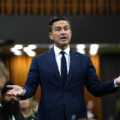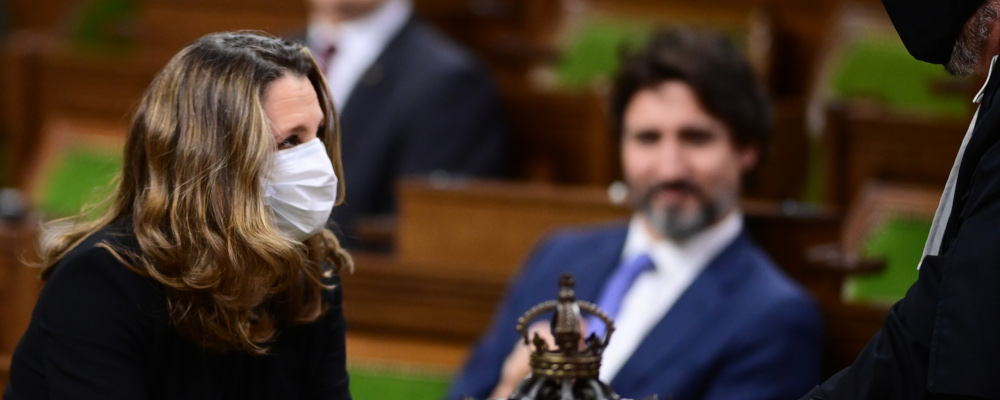Today’s budget should finally tell us how the Trudeau government intends to spend as much as $100 billion in the name of “building back better.”
It’s an extraordinary sum that’s nearly double the size of the federal stimulus package enacted in response to the 2008-09 global financial crisis.
The commitment was first made in the government’s Fall Economic Statement last December. Such a fiscal promissory note is a bit unconventional especially in light of the evolving economic and public health conditions. It seemed premature to judge how much, if any, stimulus spending would be needed to restore economy activity in the aftermath of the COVID-19 pandemic.
Of course, those conditions continue to evolve. The good news is that economic output and employment are slowly yet steadily returning to their pre-pandemic levels. The bad news is another round of strict stay-at-home orders in Ontario and other public health restrictions elsewhere in the country are bound to stall this progress.
It remains difficult to fully discern how much stimulative policies will be needed over the next several months. Presumably that will become clearer into the fall as the country’s vaccination rates catch up to peer jurisdictions and we start to see whether the economy returns to pre-pandemic levels of investment and consumption.
But the biggest problem with the Trudeau government’s $100 billion pledge isn’t even its timing. The bigger issues here are two-fold: first, the government is redefining “fiscal stimulus” to account for long-term entitlement spending; and two, it’s using large-scale deficit financing as a means to avoid grappling with real fiscal trade-offs.
The government’s redefinition of fiscal stimulus has been evident in pre-budgeting messaging from the prime minister and finance minister. This isn’t likely to be a temporary spike in federal spending in order to jolt the economy (particularly hard-hit sectors such as bars or restaurants, hotels, and so on) from its pandemic-induced coma. One could agree or disagree with the design, magnitude, and timing of such a stimulus response but at least it would broadly conform to conventional Keynesian theory.
Instead we’re bound to get a hodge-podge of new, permanent discretionary spending such as a universal national childcare program, a pharmacare program, and various other long-standing Liberal priorities that won’t just lead to a spike in short-term deficits and debt accumulation but also have serious long-term fiscal implications.
This $100 billion promise has a bit of a Dr. Evil feel to it.
This is how temporary deficits become permanent deficits and how a relatively strong balance sheet is gradually lost. It doesn’t mean that we’ll hit an immediate fiscal wall but it will invariably result in less fiscal maneuverability in the future including less scope for public investments in science and technology that can drive long-term growth and productivity.
It reflects a general feature of the Trudeau government’s modus operandi — what one might describe as “reverse deliverology.” Its policymaking too often seems to start and end with good intentions. Standard public policy considerations such as trade-offs, opportunity costs, or scarcity tend to be de-emphasized or outright dismissed. We know the sticker price, but we rarely know what we’re actually getting or what we might have gotten instead.
One can even go back to the government’s genesis to see this fiscal formula in action. Readers will recall that it came to office with a commitment to run annual deficits of $10 billion for three years. The amount seemed to matter more than specific policies and programs that would be deficit financed. As I’ve previously written, spending and deficits soon became ends in themselves.
The current $100 billion promise, which has a bit of a Dr. Evil feel to it, is similarly characterized as a self-evident public good unto itself. There’s seemingly little concern paid to whether it’s needed, how it might be delivered efficiently or effectively, or how it fits as part of a long-term strategy to boost economic growth and productivity. Just because interest rates are low in the short-term doesn’t mean that new or more spending is justified.
This isn’t how public budgeting is supposed to work. Policymakers should apply a series of questions to the budget-making process: What are the benefits and costs of individual measures? What are the trade-offs? What are we getting for this increased spending? What are the opportunity costs? How do we make these judgments in a world of fiscal scarcity?
This has been the proper critique of the Trudeau government’s fiscal policy all along. There’s been a tendency to criticize the size of its deficits or its broken promise to eliminate the deficit after just three years. But there’s been a reluctance to go another layer and ask ourselves: For a government that increased program spending by more than 25 percent even prior to the pandemic, what did we get for it? Have Canadians’ living standards markedly improved or has our economy become markedly more productive?
Some readers might answer “yes” because the Canada Child Benefit has lowered child poverty which is indeed the case. But this seems like a bit of a diversion because no matter the new benefit’s merits (and the government deserves much credit for its reforms), it was a small fraction of pre-pandemic deficit spending and it’s bound to become an even smaller share of the forthcoming deficits. It doesn’t come close to explaining the massive increase in federal program spending since 2015.
The key lesson here is that we must refocus our public debates about government spending and deficits and debt from a quantitative one to a more qualitative one. The main question shouldn’t be about whether we can afford to spend $100 billion. It’s more fundamentally about how we set our fiscal priorities, how we make judgments about competing priorities such as consumption versus investment, efficiency versus equity, and how we ensure that any incremental spending will ultimately improve the economic and social well-being of Canadians.
The problem with starting out with an undefined $100 billion promissory note (which itself will no doubt be higher because of the long-term tail of eventual spending) is it short circuits this kind of debate. It falsely creates a sense of an end of scarcity-inducing trade-offs which, notwithstanding the best efforts of the Modern Monetary Theory crowd, remains a fundamental part of public finance.
So, as readers unpack this afternoon’s budget, the questions that they should be asking ought to be less arithmetic and more directional. Where should we be prioritizing scarce public dollars? How do we balance short-term needs with long-term goals? How do we create the conditions to break out of the “two-percent growth trap” that has held back our economy for two decades? Will any of this new spending help?
Build back better? Maybe. But let’s start by understanding why, how, what we’re getting, and what we’re missing out on before we spend another $100 billion.
Recommended for You

‘We love big spending’: Janet Brown and Dave Cournoyer on Alberta’s political paradox

Need to Know: A tale of two (Albertan) cities

In defence of Ronald Reagan

Canada’s opposition parties need to think bigger, not smaller





Comments (0)